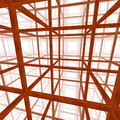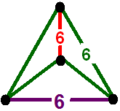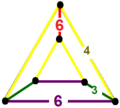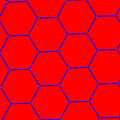Order-6 hexagonal tiling honeycomb Perspective projection viewPoincaré disk model Type Hyperbolic regular honeycomb Paracompact uniform honeycomb Schläfli symbol {6,3,6}[3] } Coxeter diagram Cells {6,3} Faces hexagon {6} Edge figure hexagon {6} Vertex figure {3,6} or {3[3] } Dual Self-dual Coxeter group Z ¯ 3 {\displaystyle {\overline {Z}}_{3}} V P ¯ 3 {\displaystyle {\overline {VP}}_{3}} [3] ]Properties Regular, quasiregular
In the field of hyperbolic geometry , the order-6 hexagonal tiling honeycomb is one of 11 regular paracompact honeycombs in 3-dimensional hyperbolic space . It is paracompact because it has cells with an infinite number of faces. Each cell is a hexagonal tiling whose vertices lie on a horosphere : a flat plane in hyperbolic space that approaches a single ideal point at infinity.
The Schläfli symbol of the hexagonal tiling honeycomb is {6,3,6}. Since that of the hexagonal tiling of the plane is {6,3}, this honeycomb has six such hexagonal tilings meeting at each edge. Since the Schläfli symbol of the triangular tiling is {3,6}, the vertex figure of this honeycomb is a triangular tiling. Thus, infinitely many hexagonal tilings meet at each vertex of this honeycomb. [ 1]
A geometric honeycomb is a space-filling of polyhedral or higher-dimensional cells , so that there are no gaps. It is an example of the more general mathematical tiling or tessellation in any number of dimensions.
Honeycombs are usually constructed in ordinary Euclidean ("flat") space, like the convex uniform honeycombs . They may also be constructed in non-Euclidean spaces , such as hyperbolic uniform honeycombs . Any finite uniform polytope can be projected to its circumsphere to form a uniform honeycomb in spherical space.
The order-6 hexagonal tiling honeycomb is a regular hyperbolic honeycomb in 3-space, and one of eleven paracompact honeycombs in 3-space.
11 paracompact regular honeycombs {6,3,3} {6,3,4} {6,3,5} {6,3,6} {4,4,3} {4,4,4} {3,3,6} {4,3,6} {5,3,6} {3,6,3} {3,4,4}
There are nine uniform honeycombs in the [6,3,6] Coxeter group family, including this regular form.
[6,3,6] family honeycombs {6,3,6} r{6,3,6} t{6,3,6} rr{6,3,6} t0,3 {6,3,6} 2t{6,3,6} tr{6,3,6} t0,1,3 {6,3,6} t0,1,2,3 {6,3,6}
This honeycomb has a related alternated honeycomb, the triangular tiling honeycomb , but with a lower symmetry:
The order-6 hexagonal tiling honeycomb is part of a sequence of regular polychora and honeycombs with triangular tiling vertex figures:
Hyperbolic uniform honeycombs : {p,3,6} Form Paracompact Noncompact Name {3,3,6} {4,3,6} {5,3,6} {6,3,6} {7,3,6} {8,3,6} ... {∞ ,3,6} Image Cells {3,3} {4,3} {5,3} {6,3} {7,3} {8,3} {∞ ,3}
It is also part of a sequence of regular polychora and honeycombs with hexagonal tiling cells:
{6,3,p } honeycombs Space H3 Form Paracompact Noncompact Name {6,3,3} {6,3,4} {6,3,5} {6,3,6} {6,3,7} {6,3,8} ... {6,3,∞ } Coxeter Image Vertex {3,3} {3,4} {3,5} {3,6} {3,7} {3,8} {3,∞ }
It is also part of a sequence of regular polychora and honeycombs with regular deltahedral vertex figures :
{p,3,p} regular honeycombs Space S3 Euclidean E3 H3 Form Finite Affine Compact Paracompact Noncompact Name {3,3,3} {4,3,4} {5,3,5} {6,3,6} {7,3,7} {8,3,8} ...{∞ ,3,∞ } Image Cells {3,3} {4,3} {5,3} {6,3} {7,3} {8,3} {∞ ,3} Vertex {3,3} {3,4} {3,5} {3,6} {3,7} {3,8} {3,∞ }
Rectified order-6 hexagonal tiling honeycomb Rectified order-6 hexagonal tiling honeycomb Type Paracompact uniform honeycomb Schläfli symbols r{6,3,6} or t1 {6,3,6} Coxeter diagrams Cells {3,6} r{6,3} Faces triangle {3}hexagon {6} Vertex figure hexagonal prism Coxeter groups Z ¯ 3 {\displaystyle {\overline {Z}}_{3}} V P ¯ 3 {\displaystyle {\overline {VP}}_{3}} [3] ]P P ¯ 3 {\displaystyle {\overline {PP}}_{3}} [3,3] ]Properties Vertex-transitive, edge-transitive
The rectified order-6 hexagonal tiling honeycomb , t1 {6,3,6}, triangular tiling and trihexagonal tiling facets, with a hexagonal prism vertex figure .
it can also be seen as a quarter order-6 hexagonal tiling honeycomb , q{6,3,6},
It is analogous to 2D hyperbolic order-4 apeirogonal tiling , r{∞ ,∞ } with infinite apeirogonal faces, and with all vertices on the ideal surface.
The order-6 hexagonal tiling honeycomb is part of a series of honeycombs with hexagonal prism vertex figures :
r{p,3,6} Space H3 Form Paracompact Noncompact Name r{3,3,6} r{4,3,6} r{5,3,6} r{6,3,6} r{7,3,6} ... r{∞ ,3,6} Image Cells {3,6} r{3,3} r{4,3} r{5,3} r{6,3} r{7,3} ∞ ,3}
It is also part of a matrix of 3-dimensional quarter honeycombs: q{2p,4,2q}
Euclidean /hyperbolic(paracompact /noncompact ) quarter honeycombs q{p,3,q}p \ q 4 6 8 ... ∞ 4 q{4,3,4} q{4,3,6} q{4,3,8} q{4,3,∞ } 6 q{6,3,4} q{6,3,6} q{6,3,8} q{6,3,∞ } 8 q{8,3,4} q{8,3,6} q{8,3,8} q{8,3,∞ } ... ∞ q{∞ ,3,4} q{∞ ,3,6} q{∞ ,3,8} q{∞ ,3,∞ }
Truncated order-6 hexagonal tiling honeycomb Truncated order-6 hexagonal tiling honeycomb Type Paracompact uniform honeycomb Schläfli symbol t{6,3,6} or t0,1 {6,3,6} Coxeter diagram Cells {3,6} t{6,3} Faces triangle {3}dodecagon {12} Vertex figure hexagonal pyramid Coxeter groups Z ¯ 3 {\displaystyle {\overline {Z}}_{3}} V P ¯ 3 {\displaystyle {\overline {VP}}_{3}} [3] ]Properties Vertex-transitive
The truncated order-6 hexagonal tiling honeycomb , t0,1 {6,3,6}, triangular tiling and truncated hexagonal tiling facets, with a hexagonal pyramid vertex figure . [ 2]
Bitruncated order-6 hexagonal tiling honeycomb Bitruncated order-6 hexagonal tiling honeycomb Type Paracompact uniform honeycomb Schläfli symbol bt{6,3,6} or t1,2 {6,3,6} Coxeter diagram Cells t{3,6} Faces hexagon {6} Vertex figure tetrahedron Coxeter groups 2 × Z ¯ 3 {\displaystyle 2\times {\overline {Z}}_{3}} [[ 6,3,6]]V P ¯ 3 {\displaystyle {\overline {VP}}_{3}} [3] ]V ¯ 3 {\displaystyle {\overline {V}}_{3}} Properties Regular
The bitruncated order-6 hexagonal tiling honeycomb is a lower symmetry construction of the regular hexagonal tiling honeycomb , hexagonal tiling facets, with a tetrahedron vertex figure .
Cantellated order-6 hexagonal tiling honeycomb Cantellated order-6 hexagonal tiling honeycomb Type Paracompact uniform honeycomb Schläfli symbol rr{6,3,6} or t0,2 {6,3,6} Coxeter diagram Cells r{3,6} rr{6,3} {}x{6} Faces triangle {3}square {4}hexagon {6} Vertex figure wedge Coxeter groups Z ¯ 3 {\displaystyle {\overline {Z}}_{3}} V P ¯ 3 {\displaystyle {\overline {VP}}_{3}} [3] ]Properties Vertex-transitive
The cantellated order-6 hexagonal tiling honeycomb , t0,2 {6,3,6}, trihexagonal tiling , rhombitrihexagonal tiling , and hexagonal prism cells, with a wedge vertex figure .
Cantitruncated order-6 hexagonal tiling honeycomb Cantitruncated order-6 hexagonal tiling honeycomb Type Paracompact uniform honeycomb Schläfli symbol tr{6,3,6} or t0,1,2 {6,3,6} Coxeter diagram Cells tr{3,6} t{3,6} {}x{6} Faces triangle {3}square {4}hexagon {6}dodecagon {12} Vertex figure mirrored sphenoid Coxeter groups Z ¯ 3 {\displaystyle {\overline {Z}}_{3}} V P ¯ 3 {\displaystyle {\overline {VP}}_{3}} [3] ]Properties Vertex-transitive
The cantitruncated order-6 hexagonal tiling honeycomb , t0,1,2 {6,3,6}, hexagonal tiling , truncated trihexagonal tiling , and hexagonal prism cells, with a mirrored sphenoid vertex figure .
Runcitruncated order-6 hexagonal tiling honeycomb The runcitruncated order-6 hexagonal tiling honeycomb , t0,1,3 {6,3,6}, truncated hexagonal tiling , rhombitrihexagonal tiling , hexagonal prism , and dodecagonal prism cells, with an isosceles-trapezoidal pyramid vertex figure .
Runcic order-6 hexagonal tiling honeycomb The runcic hexagonal tiling honeycomb , h3 {6,3,6}, hexagonal tiling , rhombitrihexagonal tiling , triangular tiling , and triangular prism facets, with a triangular cupola vertex figure .
Runicantic order-6 hexagonal tiling honeycomb The runcicantic order-6 hexagonal tiling honeycomb , h2,3 {6,3,6}, truncated trihexagonal tiling , truncated hexagonal tiling , trihexagonal tiling , and triangular prism facets, with a rectangular pyramid vertex figure .
This page is based on this
Wikipedia article Text is available under the
CC BY-SA 4.0 license; additional terms may apply.
Images, videos and audio are available under their respective licenses.
























































































